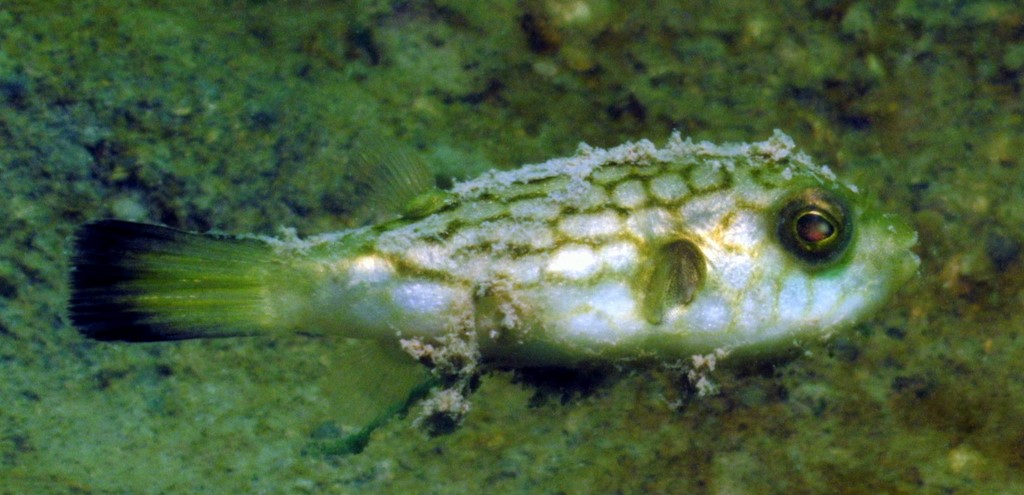CHELONODONTOPS PATOCA - (HAMILTON, 1822)
Picture courtesy of: Yves Thévenet
Actinopterygii (Gigaclass) > Actinopteri (Class) > Teleostei (Subclass) > Tetraodontiformes (Order) > Tetraodontoidei (Suborder) > Tetraodontidae (Family) > Chelonodontops (Genus)
Milkspot toadfish, Gangetic blow fish, Gangetic pufferfish, Marbled toad, Marbled toado, Milkspotted puffer, Milkspotted toadfish, Milk-spotted toadfish, Mottled pufferfish, Okinawafugu, オキナワフグ, 凹鼻魨, Cá nóc răng rùa,
Description
Color
Body brownish grey, with many large roundish white spots and 4 relatively wide dark bars (1st across eyes and last on peduncle); Longitudinal yellow area from below mouth to peduncle; All fins pale, but wide margin of caudal fin dark.
Etymology
Chelonodontops: from Greek, chelone = turtle + from Greek, odous = teeth + from ancient Greek, óps = eye, face, appearance.
patoca: from Patoka, local name for puffers (this one is called the “great Patoka”) along the Ganges River estuaries of India.
Original description: Tetrodon patoca Hamilton, 1822 - Type locality: Ganges River estuaries, India.
Distribution
Indo-West Pacific: Madagascar, Persian Gulf, India and Sri Lanka, east to French Polynesia, north to southern Japan, south to northern Australia and New Caledonia.
Biology
Usually found around the mouths of rivers or in brackish mangrove estuaries and sometimes penetrates fresh water, but is never found more than a few km from the sea. Often in schools and sometimes swims up freshwater streams. Considered a delicacy in Japan. Poisonous to eat.
Last update: 9, September 2023
Actinopterygii (Gigaclass) > Actinopteri (Class) > Teleostei (Subclass) > Tetraodontiformes (Order) > Tetraodontoidei (Suborder) > Tetraodontidae (Family) > Chelonodontops (Genus)
Milkspot toadfish, Gangetic blow fish, Gangetic pufferfish, Marbled toad, Marbled toado, Milkspotted puffer, Milkspotted toadfish, Milk-spotted toadfish, Mottled pufferfish, Okinawafugu, オキナワフグ, 凹鼻魨, Cá nóc răng rùa,
Synonymes
Arothron kappa (Bleeker, 1850)
Cheilichthys kappa (Bleeker, 1850)
Chelondon patoca (Hamilton, 1822)
Chelonodon kappa (Bleeker, 1850)
Chelonodon potoca (Hamilton, 1822)
Leiodon patoca (Hamilton, 1822)
Tetraodon kappa (Bleeker, 1850)
Tetraodon patoca (Hamilton, 1822)
Tetraodon maculatus (Swainson, 1839)
Tetrodon bourouensis (Bibron, 1855)
Tetrodon dissutidens (Cantor, 1849)
Tetrodon dorsounicolor (Bibron, 1855)
Tetrodon hartlaubii (Bianconi, 1854)
Tetrodon patoca (Hamilton, 1822)
Cheilichthys kappa (Bleeker, 1850)
Chelondon patoca (Hamilton, 1822)
Chelonodon kappa (Bleeker, 1850)
Chelonodon potoca (Hamilton, 1822)
Leiodon patoca (Hamilton, 1822)
Tetraodon kappa (Bleeker, 1850)
Tetraodon patoca (Hamilton, 1822)
Tetraodon maculatus (Swainson, 1839)
Tetrodon bourouensis (Bibron, 1855)
Tetrodon dissutidens (Cantor, 1849)
Tetrodon dorsounicolor (Bibron, 1855)
Tetrodon hartlaubii (Bianconi, 1854)
Tetrodon patoca (Hamilton, 1822)
-----------------------
Description
Dorsal soft rays (total): 9-11 (usually: 10); Anal soft rays: 8-10; Pectoral fin rays: 15-16; Body depth: 2.6-3.0 in SL; Eye diameter: 3.0-4.3 in HL; Snout: 2.2-2.4 in HL; Back evenly arched; Interorbital space flattened; Nasal organs appear as a round depression before the eyes with a low fleshy rim forming a short triangular flap on the front and rear edges. Distance between nasal organ and eye 5.8-7.7% SL. Dorsal surface of body covered with spinules from interorbital region to area between tips of pectoral fins and dorsal fin; Ventral surface with spinules from throat to just in front of anus. Caudal fin truncate to slightly rounded. Max. length: 38.0 cm SL. Depth range: 4 - 60 m.
Color
Body brownish grey, with many large roundish white spots and 4 relatively wide dark bars (1st across eyes and last on peduncle); Longitudinal yellow area from below mouth to peduncle; All fins pale, but wide margin of caudal fin dark.
Etymology
Chelonodontops: from Greek, chelone = turtle + from Greek, odous = teeth + from ancient Greek, óps = eye, face, appearance.
patoca: from Patoka, local name for puffers (this one is called the “great Patoka”) along the Ganges River estuaries of India.
Original description: Tetrodon patoca Hamilton, 1822 - Type locality: Ganges River estuaries, India.
Distribution
Indo-West Pacific: Madagascar, Persian Gulf, India and Sri Lanka, east to French Polynesia, north to southern Japan, south to northern Australia and New Caledonia.
Biology
Usually found around the mouths of rivers or in brackish mangrove estuaries and sometimes penetrates fresh water, but is never found more than a few km from the sea. Often in schools and sometimes swims up freshwater streams. Considered a delicacy in Japan. Poisonous to eat.
Similar species
Chelonodontops bengalensis (Habib, Neogi, Oh, Lee & Kim 2018) - Reported from Northeastern Indian Ocean: northern Bay of Bengal (Bangladesh, India). Chelonodontops bengalensis differs from Chelonodontops patoca with respect to dorsal rays (12 vs 10), anal rays (10 vs 8), pectoral fin rays (19 vs 15–16) and gill rakers (8 vs 7). Chelonodontops bengalensis has spinules on its lateral sides but not on the caudal peduncle (vs. a patch of spinules on the back from behind the interorbital nearly to the dorsal fin and another on the throat and abdomen but absent on the lateral sides in Chelonodontops patoca).
Last update: 9, September 2023
